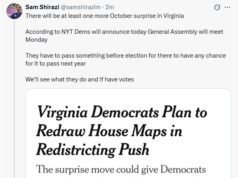by Dan Sullivan
We are approaching the second anniversary of the tragic “Unite the Right” rally. There hasn’t been a thorough investigation of the failure to guard public safety that day. There was an independent review, but executive privilege exercised by then-Governor Terry McAuliffe limited the scope. Now, with his new book (“Beyond Charlottesville: Taking a Stand Against White Nationalism”), we have the McAuliffe’s version of what happened in Charlottesville on August 11-12, 2017.
This is a first installment. It relies heavily on the account in Beyond Charlottesville. In the six months leading up to the rally there were warnings of the potential for disorder, if not violence. They were not heeded with any sense of urgency or judgement at the highest levels of state government.
Once beyond the compelling Foreword by Congressman John Lewis, the McAuliffe style of anecdotal rhetoric begins to distract from what might provide a valuable analysis. Wrapping these events in righteous indignation is a subterfuge. It should alarm Virginians that it appears we remain unprepared to respond to the next threat.
On February 6, 2017, Charlottesville City Council decided to remove the statue of Robert E Lee from a park. The mayor of Charlottesville, Mike Signer, who voted against the removal, held a press conference later in the month to declare the city a “capital of resistance” to Trump. According to the tale, Virginia Secretary of Public Safety and Homeland Security Brian Moran came to McAuliffe afterwards and told him there would be a problem.
“I’m worried they’re trying to turn Charlottesville into Berkeley.” – Brian Moran
McAuliffe says he told Moran to get his folks together and figure out what to do. That would be considered an initiating order. McAuliffe goes on to say he ran for Governor to bring the Commonwealth into the 21st century … and into a litany of accomplishments; many of which were simply riding the wake of the Obama economy. It is as if to say he did not run for Governor to deal with responsibilities of public safety and order.
Republican Corey Stewart showed up soon thereafter for a bit of what McAuliffe accurately describes as street theater. He describes Stewart as too radical (reactionary as Ms. Hendricks taught me in 9th grade) for even Trump.
Then on May 13th, enter Jason Kessler and Richard Spencer with a few dozen tiki-torch-carrying protesters. There was an altercation at the Lee statue that was dispersed. Spencer and Kessler used social media to announce that it was “time to stop apologizing…time to stop running away.” This was followed up with an application for a permit to rally on August 12th. On the application, it was clear that this was a “Unite the Right” rally in support of the Lee monument. The permitting process allowed approval without action.
McAuliffe says that “as soon as [Moran] heard about it,” he informed him. McAuliffe says he asked what the options were. Remember, McAuliffe initiated the planning process months before. Moran’s answer: “Tough one.” And McAuliffe claims Moran laid it at the feet of the local jurisdiction. McAuliffe says he knew it was going to be bad and that he wanted to collect intelligence. Early on he fails to distinguish between information and intelligence. That would be characteristic of the entire response: the use of information rather than intelligence.
Nevertheless, if the February action did not initiate planning, this action clearly did. According to McAuliffe, the Superintendent of the Virginia State Police said “The Virginia Fusion Center went into hyperdrive mining intelligence, monitoring groups, monitoring any information we could to determine who might come and what they were planning.”
At this point, McAuliffe mentions the Virginia Department of Emergency Management (VDEM). One must wonder what he knew about that Department and the Commonwealth of Virginia Emergency Operations Plan (COVEOP). The plan was updated early in his term and still has his name on it. The Foreword says it is supposed to be adopted by executive order every four years, but does not mention such an order by McAuliffe … or his successor for that matter. Like other matters McAuliffe describes during his tenure, flying by the seat of his pants appears to be the modus operandi.
Then, if it wasn’t clear by now that August 12th required detailed planning and coordination, the Ku Klux Klan held a rally on July 8th. And here McAuliffe provides further amplification of his operational awareness: “As I said at the time, ‘If you paid no attention to them, nobody would know they’re there and they’d probably just stop off at the nearest fast-food joint.” He hoped that everything would just go well.
Hope is not a course of action.
And it did not work that day. Supposedly “We learned valuable lessons that day.” Among them: how critical it would be to separate protestors, bus them to the location, and have them enter at different points. So, if those were the lessons, the exam would be August 12th.
“That was when it started to become clear that we might have an issue with local authorities in Charlottesville being responsive to state officials leading up to the ‘Unite the Right’ rally scheduled for the following month…but the rules were clear on who had authority to handle an event like this: the locals.”
When McAuliffe kicked off his first campaign for Governor, it began with a “listening tour” of Virginia. He emphasized jobs. Over time he talked about replacing the bulbs on the highway signs. And he railed against the Dillon rule, which he said prevented localities from choosing the color of their police vehicles without state approval.
“… a municipal corporation possesses and can exercise the following powers, and no others: First, those granted in express words; Second, those necessarily of fairly implied in or incident to the powers expressly granted; Third, those essential to the declared objects and purposes of the corporation, no simply convenient but indispensable. And fair, reasonable doubt concerning the existence of power is resolved by the courts against the corporation, and the power is denied.” Judge John F. Dillon
Just this year (2019), the state legislature denied the City of Charlottesville the authority to raise the salary of its mayor. But somehow the city had the authority to plan, organize, and coordinate security for an operation that included not only its own law enforcement resources, but also that of the Governor’s administration, the Virginia State Police (VSP), and the National Guard?
By turning this event into a permitting issue, McAuliffe and Moran might hang their hat on where responsibility and authority lay. But this was well beyond permitting. And well beyond the authority of anyone in Charlottesville. McAuliffe and Moran had to know that (and that explains why Moran was on the scene the night of August 11th).
“I just don’t get a sense that CPD is preparing adequately,” the head of the State Police, Colonel Flaherty, told Brian Moran in mid-July.
On July 27 the VSP hosted (my emphasis) a briefing at the Fusion Center to discuss the events of July 8th. After that meeting, McAuliffe was called while he was on vacation “to sound the alarm bell.” On August 2nd, McAuliffe’s Chief of Staff, Paul Reagan, informed him that Charlottesville was not taking the necessary precautions. “Now I was really alarmed.”
McAuliffe tells of a call to Charlottesville’s Mayor sometime afterwards and provides an email from Moran to him with “talking points.” No mission. No plan. No concept of operations. No assigned tasks. But from the description of the actions that followed, there was a growing sense of panic and confusion.
McAuliffe says that the Incident Management Team briefed at least two dozen of the Charlottesville Police Department that a vehicular attack was a possibility.
“We urged Charlottesville police to use hard barriers to block off traffic flow near the site of the demonstration, which we assumed was a given.” (my emphasis)
The die was cast. The were some last-minute maneuvers including an attempt or suggestion or some idea to move the venue of the rally. Situational awareness was simply absent. Why plan when you can react?
Tomorrow: Larry Sabato defends the Lawn.













